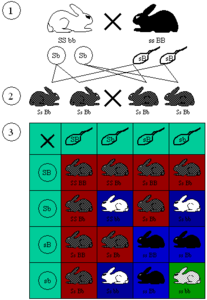Genetics
Dominant And Recessive Traits

The expression of the products of genes is not equal, and some genes will override others in expressing themselves as an inherited characteristic. The offspring of organisms that reproduce sexually contain a set of chromosome pairs, half from the father and half from the mother. However, normally people do not have one blue eye and one brown eye, or half brown hair and half blond hair because most genetic traits are the result of the expression of either the dominant or the recessive genes. If a dominant and a recessive gene appear together (the heterozygous condition), the dominant will always win, producing the trait it is coded for. The only time a recessive trait (such as the one for blond hair) expresses itself is when two recessive genes are present (the homozygous condition). As a result, parents with heterozygous genes for brown hair could produce a child with blond hair if the child inherits two recessive blond-hair genes from the parents. The genes residing in the chromosome's DNA can also be present in alternative forms called alleles. It is important to note that some characteristics are a result of presence of various alleles, e.g. pink snapdragon flowers or blood types.
This hereditary law also holds true for genetic diseases. Neither parent may show signs of a genetic disease, caused by a defective gene, but they can pass the double-recessive combination on to their children. Some genetic diseases are dominant and others are recessive. Dominant genetic defects are more common because it only takes one parent to pass on a defective allele. A recessive genetic defect requires both parents to pass on the recessive allele that causes the disease. A few inherited diseases (such as Down syndrome) are caused by abnormalities in the number of chromosomes, where the offspring has 47 chromosomes instead of the normal 46.
Additional topics
Science EncyclopediaScience & Philosophy: Gastrula to Glow dischargeGenetics - The History Of Genetics, The Biology Of Genetics, The Genetic Code, Dominant And Recessive Traits